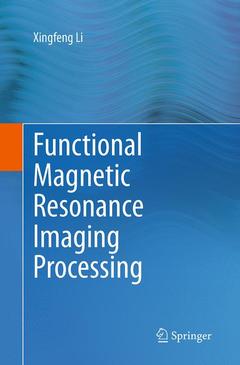Description
Functional Magnetic Resonance Imaging Processing, Softcover reprint of the original 1st ed. 2014
Author: Li Xingfeng
Language: English
Subjects for Functional Magnetic Resonance Imaging Processing:
Functional Magnetic Resonance Imaging Processing
Publication date: 08-2016
Support: Print on demand
Publication date: 08-2016
Support: Print on demand
Functional Magnetic Resonance Imaging Processing
Publication date: 09-2013
221 p. · 15.5x23.5 cm · Hardback
Publication date: 09-2013
221 p. · 15.5x23.5 cm · Hardback
Description
/li>Contents
/li>Biography
/li>Comment
/li>
With strong numerical and computational focus, this book serves as an essential resource on the methods for functional neuroimaging analysis, diffusion weighted image analysis, and longitudinal VBM analysis. It includes four MRI image modalities analysis methods. The first covers the PWI methods, which is the basis for understanding cerebral flow in human brain. The second part, the book?s core, covers fMRI methods in three specific domains: first level analysis, second level analysis, and effective connectivity study. The third part covers the analysis of Diffusion weighted image, i.e. DTI, QBI and DSI image analysis. Finally, the book covers (longitudinal) VBM methods and its application to Alzheimer?s disease study.
Preface.- MRI perfusion weighted imaging analysis.- Perfusion imaging.- Gamma-variate fitting.- AIF selection.- Dispersion effects in DSC-MRI.- -Summary of the PWI algorithm.- First level fMRI data analysis for activation detection.- fMRI experimental design.- fMRI data pre-processing.- Activation detection: model free and model based methods.- Models for hemodynamic response function and drift.- General linear model (GLM) for activation detect.- Hypothesis test and threshold correction.- Summary of algorithm for 1st level fMRI data analysis.- 2nd level fMRI data analysis using mixed model.- Mixed model for fMRI data analysis.- Numerical analysis for mixed effect models.- Iterative trust region method for ML estimation.- Exception trust region algorithm for second level fMRI data analysis.- Degree of freedom (DF) estimation.- fMRI data analysis future directions.- Second level fMRI data processing algorithm summary.- fMRI effective connectivity study.- Nonlinear system identificationmethod for fMRI effective connectivity analysis.- Model selections for effective connectivity study.- Robust method for second level analysis.- Effective connectivity for resting-state fMRI data.- Limitations for fMRI effective connectivity in this study.- Summary of the algorithm for fMRI effective connectivity study.Diffusion weighted imaging analysis.- Basic principle of diffusion MRI and DTI data analysis.- Fiber tracking.- High angular resolution diffusion imaging (HARDI) analysis.- Adaptive Q-ball imaging regularization.- Diffusion spectrum imaging.- Summary and future directions.- Summary of DTI, QBI and DSI image analysis methods.- Voxel based morphometry and its application to Alzheimer’s disease study.- Background for voxel based morphometry analysis.- Enhanced VBM.- Longitudinal VBM and its application to AD study.- Effective connectivity for longitudinal data analysis.- Other type of sMRI data analysis.- Summary of (longitudinal) VBM analysis methods.- Appendixes.- Questionanswers and hints.
Dr. Xingfeng Li obtained his first degree in automation control, master degree of engineer in power system control, and Ph.D. degree in pattern recognition and machine intelligence in 1996, 2001, and 2004, respectively. Since then, he has been working in various research institutions in different countries on MRI and PET image analysis. He worked as postdoc research fellow from 2004-2009 at McGill University in Canada and INSERM, Paris 6th University in France. From 2009–2013, he has been a research fellow at the University of Ulster, UK. He is currently working on applying nonlinear system identification theory for studying nonlinear dynamic brain system. He conducts extensive research work using fMRI, diffusion weighted imaging, perfusion weighted imaging, structural MRI, and PET methods to investigate human brain system. His research interests include functional medical imaging analysis, numerical analysis, statistical analysis, nonlinear system identification, and optimization algorithms. He has published dozen of papers in the journals NeuroImage, IEEE Transaction on Medical Imaging, and Medical Image Analysis. He is also a member of the editorial board of Journal of Nonlinear Dynamics.
Mathematical equations with computer program algorithm implementation Wide range of methods for magnetic resonance image analysis Dealing with different image modalities State of the art algorithms for data analysis Includes supplementary material: sn.pub/extras
© 2024 LAVOISIER S.A.S.




